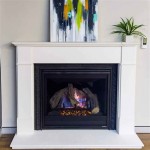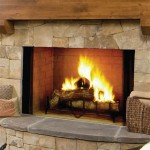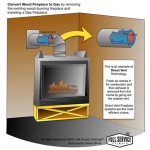How To Clean Soot From Fireplace Glass
The accumulation of soot on fireplace glass is a common occurrence, often obscuring the view of the flames and diminishing the aesthetic appeal of the fireplace. This soot, a byproduct of incomplete combustion, is a complex mixture of carbon particles, ash, creosote, and other organic compounds. Its stubborn adherence to glass surfaces necessitates specific cleaning techniques and appropriate cleaning agents to ensure effective removal without causing damage to the glass or surrounding fireplace components.
Understanding the composition of soot is crucial for selecting the most effective cleaning method. The primary component, carbon, is usually responsible for the dark coloration. Ash contributes to the gritty texture, while creosote, a flammable byproduct of burning wood, can create a sticky, difficult-to-remove layer. Proper cleaning not only enhances the fireplace's appearance but also contributes to its safe operation by minimizing the risk of creosote buildup, which can pose a fire hazard.
Before embarking on any cleaning procedure, prioritizing safety is paramount. This involves ensuring the fireplace is completely cool, as working on a hot surface can lead to burns and potentially damage the glass. Wearing appropriate protective gear, such as gloves and eye protection, is also recommended to prevent skin irritation or exposure to cleaning chemicals. Adequate ventilation is also important, especially when using commercially available cleaning products that may emit fumes.
Preparing the Fireplace for Cleaning
The first step in cleaning fireplace glass is proper preparation. This involves gathering the necessary supplies and protecting the surrounding area from potential spills or splatters. Recommended supplies include a dry brush or vacuum cleaner with a brush attachment, cleaning solutions (either homemade or commercial), a spray bottle (if using a liquid cleaner), a non-abrasive sponge or microfiber cloth, and protective gloves and eye protection. A drop cloth or old newspapers should be laid down to protect the hearth and any nearby flooring.
The preliminary step involves removing loose debris and ash from the fireplace. Using a dry brush or a vacuum cleaner with a brush attachment, gently sweep away any loose ash or soot from the glass surface and the surrounding firebox. This step prevents the buildup of excess grime during the cleaning process and minimizes the risk of scratching the glass with trapped particles. It is important to avoid using excessive force during this step, as abrasive materials can damage the glass surface.
After removing loose debris, inspect the fireplace glass to assess the severity of the soot buildup. This assessment will help determine the appropriate cleaning method and the intensity of scrubbing required. Light soot deposits may be easily removed with a gentle cleaning solution, while heavy deposits may require a more aggressive approach or a specialized cleaning product. Pay attention to any areas with particularly thick or stubborn soot buildup, as these areas may require pre-treatment or extra attention during the cleaning process.
Effective Cleaning Methods for Fireplace Glass
Several cleaning methods are available for removing soot from fireplace glass, ranging from homemade solutions utilizing readily available ingredients to commercially formulated cleaning products. The choice of method often depends on the severity of the soot buildup, the availability of supplies, and personal preference. It is generally recommended to start with the gentlest method and gradually escalate to more aggressive approaches if necessary.
One popular homemade cleaning solution involves mixing equal parts of white vinegar and water in a spray bottle. This solution is mildly acidic and can effectively dissolve light soot deposits. To use this method, spray the vinegar and water solution liberally onto the fireplace glass and allow it to sit for a few minutes. Then, using a non-abrasive sponge or microfiber cloth, gently scrub the glass in a circular motion. Rinse the glass with clean water and dry it with a clean cloth.
Another effective homemade cleaning solution involves using baking soda as a mild abrasive. To use this method, mix baking soda with a small amount of water to create a paste. Apply the paste to the fireplace glass and allow it to sit for a few minutes. Then, using a non-abrasive sponge or microfiber cloth, gently scrub the glass in a circular motion. Rinse the glass with clean water and dry it with a clean cloth. It is important to avoid using excessive pressure when scrubbing with baking soda, as it can potentially scratch the glass surface.
For heavier soot deposits, commercially available fireplace glass cleaners may be necessary. These cleaners are specifically formulated to dissolve stubborn soot and creosote without damaging the glass. When using commercial cleaners, it is crucial to follow the manufacturer's instructions carefully. Typically, the cleaner is sprayed onto the glass and allowed to sit for a specified period before being scrubbed with a non-abrasive sponge or cloth and rinsed with clean water. Always ensure adequate ventilation when using commercial cleaning products, as they may contain strong chemicals.
Techniques for Stubborn Soot Removal
In some cases, soot buildup on fireplace glass can be particularly stubborn and resistant to conventional cleaning methods. This may occur due to prolonged exposure to high temperatures or the presence of creosote, which can form a tenacious bond with the glass surface. In such instances, specialized techniques and cleaning agents may be required to effectively remove the soot.
One effective technique for removing stubborn soot involves using a razor blade scraper designed for glass surfaces. This tool can carefully shave away layers of soot without scratching the glass if used correctly. It is essential to hold the razor blade at a shallow angle to the glass and apply gentle, even pressure. Avoid using excessive force or angling the blade too steeply, as this can result in scratches. After scraping away the soot, clean the glass with a standard cleaning solution to remove any remaining residue.
Another option for removing stubborn soot is to use a commercial fireplace glass cleaner specifically designed for heavy-duty cleaning. These cleaners often contain stronger solvents and detergents that can effectively dissolve even the most tenacious soot deposits. When using heavy-duty cleaners, it is crucial to follow the manufacturer's instructions carefully and to wear appropriate protective gear, such as gloves and eye protection. Ensure adequate ventilation and avoid prolonged exposure to the fumes.
For extremely stubborn soot deposits, multiple cleaning applications may be necessary. In such cases, it is recommended to repeat the cleaning process several times, allowing the cleaning solution to sit on the glass for a longer period during each application. This allows the cleaning agents to penetrate the soot layer and weaken its bond with the glass. After each application, scrub the glass gently with a non-abrasive sponge or cloth and rinse with clean water.
An alternative approach for particularly difficult soot removal is the use of a pumice stone specifically designed for cleaning glass. Before using a pumice stone, ensure that both the stone and the glass are wet to minimize the risk of scratching. Gently rub the pumice stone over the sooty areas in a circular motion, applying light pressure. The abrasive nature of the pumice stone helps to remove the soot without damaging the glass. After using the pumice stone, thoroughly rinse the glass with clean water and dry it with a clean cloth. It’s important to only use pumice stones explicitly marked as safe for glass.
After cleaning the fireplace glass, it is essential to thoroughly rinse and dry the surface. This removes any remaining cleaning solution or residue and prevents streaking or spotting. Use clean water and a clean, lint-free cloth or microfiber towel to rinse the glass. Then, use a separate clean, dry cloth to dry the glass completely. For a streak-free finish, consider using a glass cleaner specifically designed for windows and mirrors.
Preventing future soot buildup is an ongoing effort. Ensure the fireplace is properly ventilated while in use by opening the damper fully. Burn only seasoned, dry wood, as wet or unseasoned wood produces more smoke and soot. Avoid burning treated or painted wood, as these materials can release harmful chemicals and contribute to soot buildup. Regular fireplace maintenance, including chimney sweeping and inspection, is essential for preventing excessive soot buildup and ensuring the safe operation of the fireplace.

How To Clean A Fireplace With Bar Keepers Friend

Easy Clean Soot Off Fireplace Glass

How To Remove Soot From Stove Glass Scan

How To Clean A Stove Glass Arc Building S

How To Clean Fireplace Glass The Right Way

How To Clean Fireplace Glass Doors Vertical Chimney Care

How To Clean Soot Off Fireplace Glass

How To Clean Fireplace Glass Wood And Gas Fireplaces Anita S Housekeeping

Gas Fireplace Glass Tips For Cleaning On Fireplaces

How To Clean Fireplace Glass Naturally And For Free Shield Home Watch








